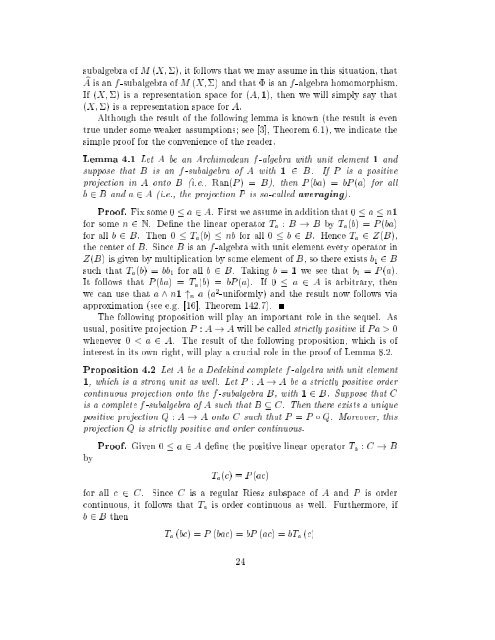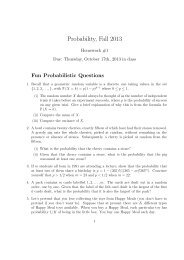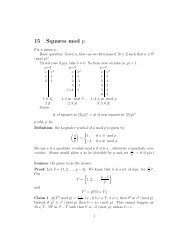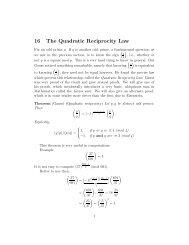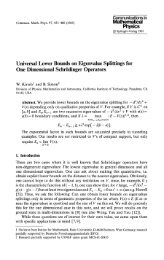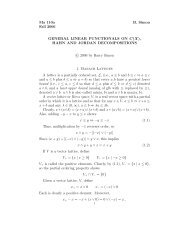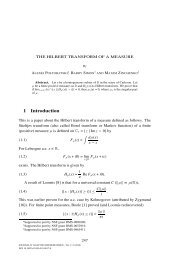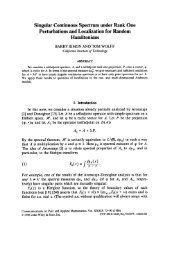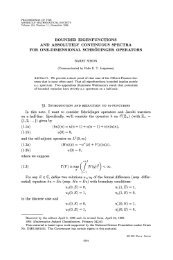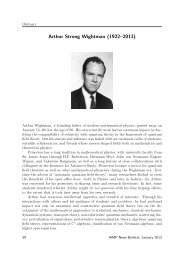Representations of positive projections 1 Introduction - Mathematics ...
Representations of positive projections 1 Introduction - Mathematics ...
Representations of positive projections 1 Introduction - Mathematics ...
You also want an ePaper? Increase the reach of your titles
YUMPU automatically turns print PDFs into web optimized ePapers that Google loves.
subalgebra <strong>of</strong> M (X ), it follows that we may assume in this situation, that<br />
bA is an f-subalgebra <strong>of</strong> M (X ) and that is an f-algebra homomorphism.<br />
If (X ) is a representation space for (A 1), then we will simply say that<br />
(X ) is a representation space for A.<br />
Although the result <strong>of</strong> the following lemma is known (the result is even<br />
true under some weaker assumptions see [3], Theorem 6.1), we indicate the<br />
simple pro<strong>of</strong> for the convenience <strong>of</strong> the reader.<br />
Lemma 4.1 Let A be an Archimedean f-algebra with unit element 1 and<br />
suppose that B is an f-subalgebra <strong>of</strong> A with 1 2 B. If P is a <strong>positive</strong><br />
projection in A onto B (i.e., Ran(P ) = B), then P (ba) = bP (a) for all<br />
b 2 B and a 2 A (i.e., the projection P is so-called averaging).<br />
Pro<strong>of</strong>. Fix some 0 a 2 A. First we assume in addition that 0 a n1<br />
for some n 2 N. De ne the linear operator Ta : B ! B by Ta(b) = P (ba)<br />
for all b 2 B. Then 0 Ta(b) nb for all 0 b 2 B. Hence Ta 2 Z(B),<br />
the center <strong>of</strong> B. Since B is an f-algebra with unit element every operator in<br />
Z(B) is given by multiplication by some element <strong>of</strong>B, so there exists b 1 2 B<br />
such that Ta(b) = bb 1 for all b 2 B. Taking b = 1 we see that b 1 = P (a).<br />
It follows that P (ba) = Ta(b) = bP (a). If 0 a 2 A is arbitrary, then<br />
we can use that a ^ n1 "n a (a 2 -uniformly) and the result now follows via<br />
approximation (see e.g. [16], Theorem 142.7).<br />
The following proposition will play an important role in the sequel. As<br />
usual, <strong>positive</strong> projection P : A ! A will be called strictly <strong>positive</strong> if Pa > 0<br />
whenever 0 < a 2 A. The result <strong>of</strong> the following proposition, which is <strong>of</strong><br />
interest in its own right, will play a crucial role in the pro<strong>of</strong> <strong>of</strong> Lemma 8.2.<br />
Proposition 4.2 Let A be aDedekind complete f-algebra with unit element<br />
1, which is a strong unit as well. Let P : A ! A be a strictly <strong>positive</strong> order<br />
continuous projection onto the f-subalgebra B, with 1 2 B. Suppose that C<br />
is a complete f-subalgebra <strong>of</strong>A such that B C. Then there exists a unique<br />
<strong>positive</strong> projection Q : A ! A onto C such that P = P Q. Moreover, this<br />
projection Q is strictly <strong>positive</strong> and order continuous.<br />
by<br />
Pro<strong>of</strong>. Given 0 a 2 A de ne the <strong>positive</strong> linear operator Ta : C ! B<br />
Ta(c) =P (ac)<br />
for all c 2 C. Since C is a regular Riesz subspace <strong>of</strong> A and P is order<br />
continuous, it follows that Ta is order continuous as well. Furthermore, if<br />
b 2 B then<br />
Ta (bc) =P (bac) =bP (ac) =bTa (c)<br />
24


